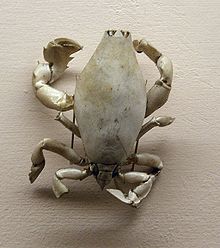Raninidae
| Raninidae Temporal range:
| |
|---|---|

| |
| Lyreidus tridentatus | |
| Scientific classification | |
| Domain: | Eukaryota |
| Kingdom: | Animalia |
| Phylum: | Arthropoda |
| Class: | Malacostraca |
| Order: | Decapoda |
| Suborder: | Pleocyemata |
| Infraorder: | Brachyura |
| Section: | Raninoida |
| Superfamily: | Raninoidea |
| Family: | Raninidae De Haan, 1839 |
| Genera | |
|
See text | |
Raninidae is a family of unusual crabs, sometimes known as "frog crabs", on account of their frog-like appearance. They are taken by most scientists to be quite primitive among the true crabs. They closely resemble the (unrelated) mole crabs, due to parallel evolution or convergent evolution. In both groups, the claws are modified into tools for digging, and the body is a rounded shape that is easy to bury in sand. Unlike most other true crabs, the abdomens of raninids are not curled under the cephalothorax.
The earliest fossil attributable to the family Raninidae dates from the Albian.[1]
Taxonomy

The 46 extant and 183 extinct species in the famila Raninidae are arranged among 34 genera in 7 subfamilies:[2]
|
|
References
- ^ Andreas Brösing (2008). "A reconstruction of an evolutionary scenario for the Brachyura (Decapoda) in the context of the Cretaceous–Tertiary boundary" (PDF). Crustaceana. 81 (3): 271–287. CiteSeerX 10.1.1.652.1701. doi:10.1163/156854008783564091.
- ^ Sammy De Grave; N. Dean Pentcheff; Shane T. Ahyong; et al. (2009). "A classification of living and fossil genera of decapod crustaceans" (PDF). Raffles Bulletin of Zoology. Suppl. 21: 1–109.
